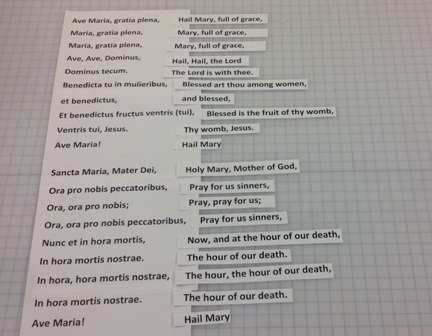Tonight we will be focusing our attention on David: shepherd and king who points the way to Jesus, the Good Shepherd and Christ the King. Here’s the plan.
David: Shepherd and King
BIG IDEA
David: shepherd and king, points the way to Jesus: the Good Shepherd and Christ the King
PRELIMINARIES (15 mins)
- Return corrected Ten Commandments quizzes.
- Opening procession to set up prayer table
- Opening prayer ritual
ENGAGE (20 mins)
- Invite volunteer to come forward to put on shepherd costume.
- Talk about the role of a shepherd and the use of the staff to keep sheep from straying, protect the sheep from danger.
- Introduce David, the greatest king of Israel, who began as a shepherd.
- Scripture reading: 1 Samuel 16:6-13 (David is anointed king) – reader = Izzy
EXPLORE (35 mins)
- Pass the shepherd’s staff to volunteers to read pages 52-53 of Finding God about David.
- Invite students to share out loud their homework: “If I Were King or Queen for a Day.”
- Have the students declare one among them king or queen based on their homework.
- Invite that student to come forward for a “coronation.”
- Place “robe” around his or her shoulders and process them around the room. (Play recording of trumpet fanfare.)
- Have the king/queen stand front and center and then invite the other students to come forward, presenting the following and have them read the description as they do so (have each student bend their knee to the king/queen):
- Crown – your majesty, I present you with this crown, a symbol of your glorious victories.
- Scepter – your majesty, I present you with this royal scepter, a symbol of your divine power and authority.
- Throne (teacher’s chair!) – your majesty, I present you with this throne, a symbol of your presence in our center, holding us together in unity.
- Scrolls/decrees – your majesty, I present you with these scrolls on which are inscribed the laws by which you will keep order.
- Statue – your majesty, I present you with this miniature statue in anticipation of the great statue that will be erected in your honor to symbolize all of your ideal qualities.
- Sword – your majesty, I present you with this sword by which you will protect your people, especially those who are most vulnerable.
- Scales of Justice – your majesty, I present you with these scales of justice to symbolize the fairness and justice with which you shall rule.
- Child/doll – your majesty, I present you with your heir who is a living symbol of your life-giving rule.
- Medals – your majesty, I present you with these medals to symbolize the honor of your achievements as well as the honors that you will bestow upon your faithful servants.
- Blueprints for Monument – your majesty, I present you with these plans for a great monument to be built in your honor as a symbol of your enduring legacy and your presence with us for all eternity.
Here’s a pic of me with all of the above props!
- Next distribute Bibles and pens along with the handout Symbols of Royalty.
- Have the students work independently matching the royal symbols with their meanings and then looking up the Scripture passages that show how Jesus exemplified these royal qualities.
- When they are finished, review the handout. (Symbols of Royalty answer key)
REFLECT (15 mins)
- Direct young people to their “sacred space” taking with them their tea-light candle and their textbook open to page 54.
- Invite young people to still themselves and then play “Shepherd Me, O God” (Marty Haugen), reminding them that David “wrote” the Psalms and that, although we don’t have original melodies, we have contemporary melodies with the words from Psalms.
- Invite the young people to pray aloud the words of the prayer on pg. 54 of Finding God. Have the girls take the role of Group A and the boys Group B. Pause in between each group’s part and signal to begin with chime.
RESPOND (5 mins)
- Tell the young people that the Psalms in the Bible are attributed to King David and that they help us to pray in any situation and in any mood.
- Distribute the Homework Notification Sheet that asks the parents to help their child bring in a CD of a song that expresses one of the following emotions: happiness, loneliness, sadness, hope, fear, thankfulness, anger, contentment, depression, disappointment, uncertainty, restlessness, outrage (over an injustice).
- Closing prayer – young people bless themselves with holy water as they leave.





Joe, I love your creativity! Thank you for inspiring us and helping us keep our lessons fresh and alive. I’m not a sixth grade catechist, but your ideas are so adaptable that I can use them in my primary classroom.
I will however, share your lesson with our middle school catechist. Again, thank you.
You’re welcome Wanda! Adapt, adapt, adapt! 😉